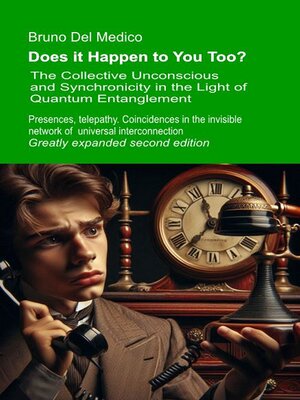Does it Happen to You Too? Greatly expanded.
ebook ∣ The Collective Unconscious and Synchronicity in the Light of Quantum Entanglement. Presences, telepathy. Coincidences in the invisible network of universal interconnection.
By Bruno Del Medico

Sign up to save your library
With an OverDrive account, you can save your favorite libraries for at-a-glance information about availability. Find out more about OverDrive accounts.
Find this title in Libby, the library reading app by OverDrive.



Search for a digital library with this title
Title found at these libraries:
| Library Name | Distance |
|---|---|
| Loading... |
Have you ever experienced a moment when a seemingly trivial coincidence turned out to be so significant that it left you speechless? Perhaps you thought of a person you hadn't heard from in years, and minutes later, that same person called you on the phone. Or maybe you dreamed about an event, and the next day it came true in great detail. Does this happen to you, too? These experiences, which defy logic and seem to suggest a hidden order in the universe, are what Carl Jung called synchronicity: the apparent connection between events with no causal link, but rich in deep meaning. This book will take you on a journey through the invisible traces that seem to connect the human mind with reality and the laws of the cosmos. Along the way, we will explore strange coincidences, presentiments and telepathy. We will tell how Jung, with his concept of the collective unconscious, gave a theoretical face to these phenomena. We will discover surprising parallels with one of the most enigmatic discoveries in modern physics: quantum entanglement, that phenomenon whereby particles separated in space remain mysteriously connected.
History is full of puzzling coincidences that seem to transcend chance. These events send us back to a crucial question: do we really create our own destiny, or is there a "blueprint" that manifests itself through synchronic events, suggesting a network of invisible connections?
Carl Jung devoted much of his life to exploring the human unconscious, discovering that it is not only individual but also collective. Inside each of us live universal symbols, images and ideas that cross eras and cultures. He called them archetypes. Imagine the archetype of the "wayfarer" or that of the "hero." You find them in Greek mythology (Ulysses), modern fiction (Harry Potter) and even in the dreams of ordinary people. Jung argued that these archetypes reside deep in our unconscious and often manifest themselves precisely through dreams or synchronic coincidences. In this way, synchronicity becomes a universal language, a way to connect us to something greater. A famous example of synchronicity related to archetypes is one described by Jung himself. He tells of a patient who was recounting her dream of a golden beetle. Just as she was speaking, a similar beetle landed on the study window. For Jung, the event was not accidental: the "beetle" was an archetypal symbol of transformation, which had deep meaning for the patient. Quantum physics, seemingly distant from the world of psychology, revealed a deep and mysterious interconnection between particles. The phenomenon of quantum entanglement shows that two particles separated by an infinite distance can influence each other instantaneously. But what happens if we extend these principles to the human mind? In recent years, many theories have suggested that consciousness itself might function similarly to quantum fields. Anecdotes of telepathy and hunches seem to suggest that our minds are connected by invisible connections, much like particles in entanglement. As philosopher Erwin Schrödinger, one of the fathers of quantum mechanics, wrote: "Consciousness is one. There is no pluralism of consciousness." Jung, with his psychological outlook, and Schrödinger, with his scientific approach, seem to suggest that there is a universal network of connections that binds us to each other and to the universe. Perhaps, as you read these pages, you will discover that the coincidences you have experienced are not isolated events, but fragments of a grand design. It will be an invitation to see the world with new eyes. Because, in the end, it happens to you, too.







